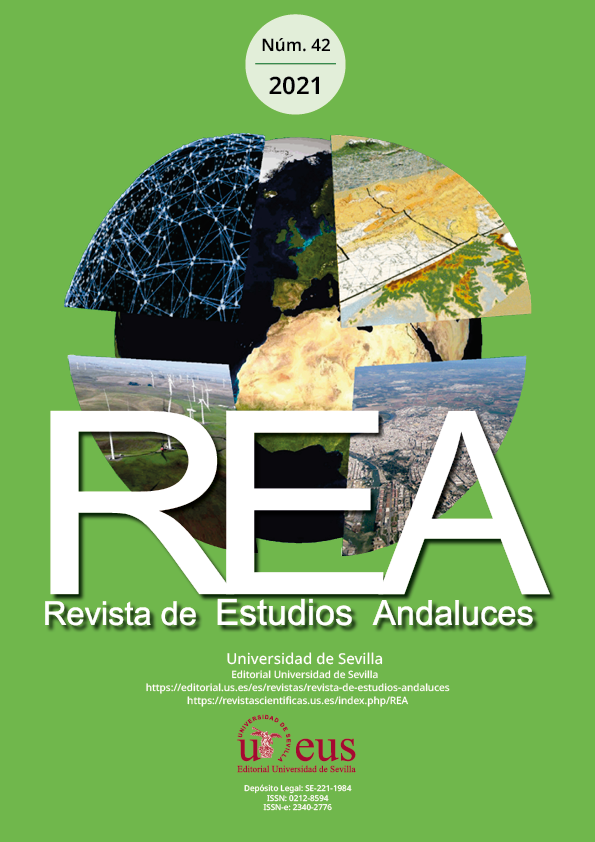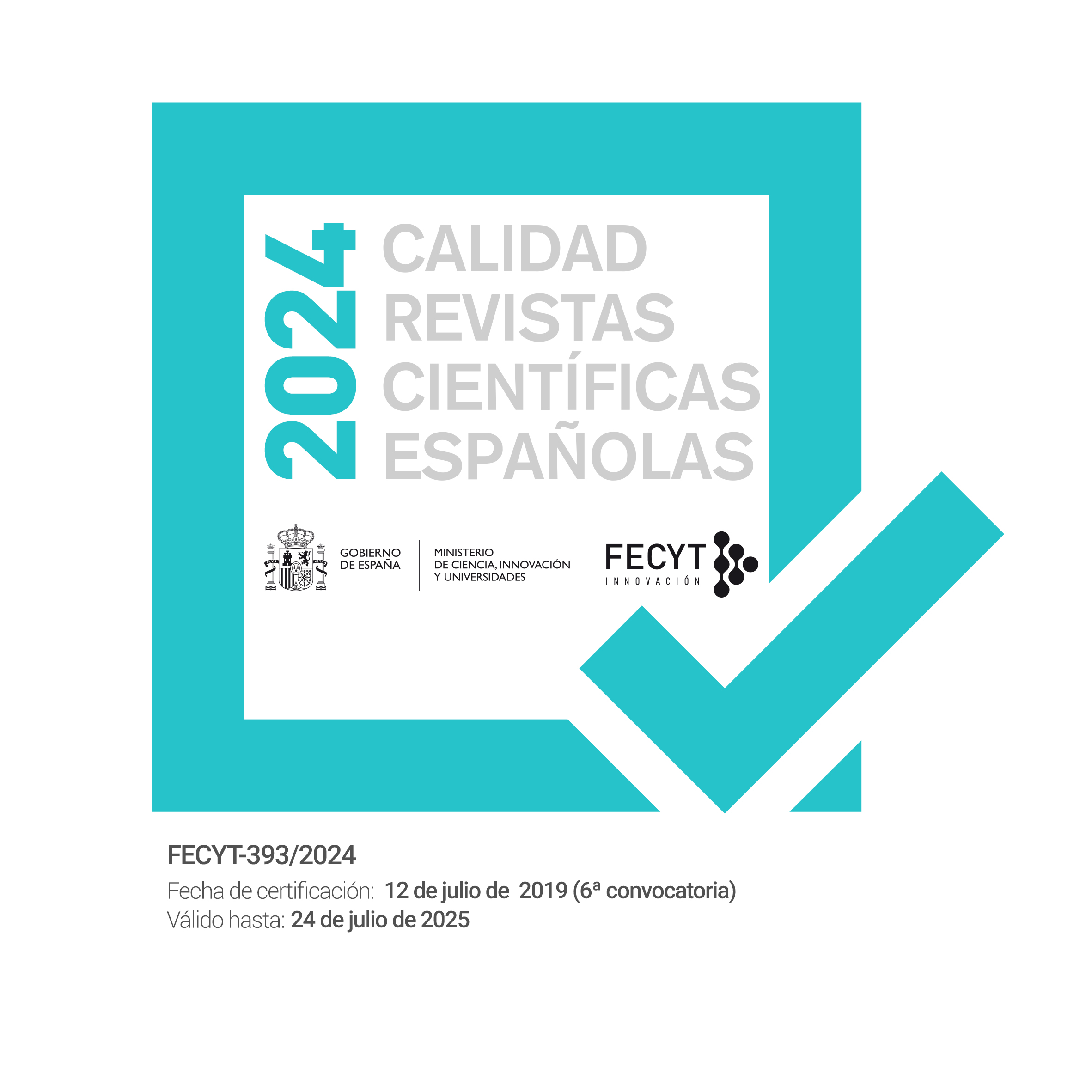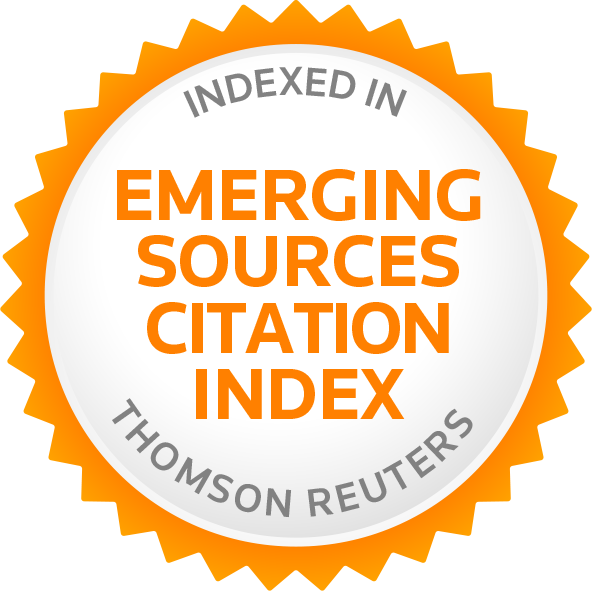Temperaturas mínimas estivales en el sureste de la península ibérica a partir de termografías satelitales
DOI:
https://doi.org/10.12795/rea.2021.i42.01Palabras clave:
Gradiente altitudinal, Inversión térmica, Polo frío, Termografía, Canícula, Temperaturas mínimas, Sureste peninsular, TeledetecciónResumen
La posición latitudinal del sureste de la península ibérica genera temperaturas medias elevadas (entre 25 y 30oC) durante la época estival, si bien, su compleja orografía y el importante gradiente altitudinal, genera importantes diferencias en las temperaturas mínimas, influenciadas especialmente por intensos procesos de inversiones térmicas nocturnas (ITN) en valles de interior. El incremento de nuevas estaciones meteorológicas y el aumento de la densidad de las redes de observación, unida a la implantación de una red propia de termómetros registradores en polos fríos (CAP) de las provincias de Murcia, Albacete o Jaén, lleva a un mayor conocimiento de la distribución de temperaturas nocturnas superficiales. El principal objetivo de la investigación es la generación de cartografía (termografías) que refleje la distribución de las temperaturas nocturnas en el sureste de la Península Ibérica, realizada a través del tratamiento de productos satelitales (VIIRS LST Band I5 del satélite SUOMI-NPP. Unido al uso de las imágenes satelitales (termografías) es posible analizar detalladamente los contrastes térmicos existentes durante el periodo canicular a través de 147 estaciones meteorológicas y termómetros registradores (15 de julio al 15 de agosto) de los años 2017 a 2020. La verificación de las termografías utilizadas (producto Band I5) muestra un notable ajuste estadístico (R2 de 0,87), con un Bias y RMSE de -0,2 y 1,83oC respectivamente. La cartografía es realizada para las diferencias provincias que integran el sureste de la península ibérica (Alicante, Albacete, Murcia, Jaén, Granada y Almería). Las diferencias térmicas diarias aportadas por las estaciones meteorológicas superficiales arrojan contrastes de temperaturas mínimas de hasta 23,4oC entre valles elevados de interior y ámbitos litorales
Descargas
Citas
Allende, F. A., Fernández, F. G., Rasilla, D.A. & Alcaide, J.M. (2018). Isla de calor nocturna estival y confort térmico en Madrid: avance para un planeamiento térmico en áreas urbanas. Ciudad y Territorio Estudios Territoriales (CyTET), 50(195), 101-120. https://doi.org/10.37230/CyTET.2021.M21
Anderson, M.C., Kustas, W.P., Norman, J.M., Hain, C.R., Mecikalski, J.R., Schultz, L. & Gao, F. (2011). Mapping daily evapotranspiration at field to continental scales using geostationary and polar orbiting satellite imagery. Hydrology and Earth System Sciences, 15(1), 223-239. https://doi.org/10.5194/hess-15-223-2011
Arduini, G., Chemel, C. & Staquet, C. (2020). Local and non-local controls on a persistent cold-air pool in the Arve River Valley. Quarterly Journal of the Royal Meteorological Society. https://doi.org/10.1002/qj.3776
Bolstad, P.V., Swift, L., Collins, F. & Régnière, J. (1998). Measured and predicted air temperatures at basin to regional scales in the southern Appalachian Mountains. Agricultural and Forest Meteorology, 91(3-4), 161-176. https://doi.org/10.1016/S0168-1923(98)00076-8
Cao, C., Xiong, X., Wolfe, R., De Luccia, F., Liu, Q., Blonski, S.,... & Hillger, D. (2013). Visible infrared imaging radiometer suite (VIIRS) sensor data record (SDR) user’s guide. NOAA Technical Report NESDIS: College Park, MD, USA.
Chai, T. & Draxler, R.R. (2014). Root mean square error (RMSE) or mean absolute error (MAE). Geoscientific Model Development Discussions, 7(1), 1525-1534. https://doi.org/10.5194/gmd-7-1247-2014
Clements, C.B., Whiteman, C.D. & Horel J.D. (2003). Cold-air-pool structure and evolution in a mountain basin: Peter Sinks, Utah. Journal of Applied Meteorology, 42, 752-768. https://doi.org/10.1175/1520-0450(2003)042<0752:CSAEIA>2.0.CO;2
Daly, CH. Conklin, D.R. & Unsworth, M.H. (2009). Local atmospheric decoupling in complex topography alters climate change impacts. International Journal of Climatology, 30(12), pp. 1857-1864. https://doi.org/10.1002/joc.2007
Dodson, R. & Marks, D. (1997). Daily air temperature interpolated at high spatial resolution over a large mountainous region. Climate Research, 8(1), 1-20. https://doi.org/10.3354/cr008001
Duan, S.B., Li, Z.L., Li, H., Göttsche, F.M., Wu, H., Zhao, W. & Coll, C. (2019). Validation of Collection 6 MODIS land surface temperature product using in situ measurements. Remote sensing of environment, 225, 16-29. https://doi.org/10.1016/j.rse.2019.02.020
Eisenbach, S., Pospichal, B., Whiteman, C.D., Steinacker, R. & Dorninger, M. (2003). Classification of cold air pool events in the Gstettneralm, a sinkhole in the Eastern Alps. [Comunicación en congreso]. Extended Abstracts, Int. Conf. on Alpine Meteorology and MAP-Meeting, Brig, Switzerland, MeteoSwiss, Publication 66, 157–160.
Espín Sánchez, D. Conesa García C. & Castejón Porcel, G. (2018a). Temperature inversions due to warm air advections at low levels: significant thermal constrast in the Vega Media of the Segura River (Southeast Spain)”. In: Advances in Environmental Research Publisher: Nova Science Publishers (New York). http://doi.org/10.3989/estgeogr.201416
Espín Sánchez, D., Ruiz Álvarez, V., Martí Talavera, J. & García Marín, R. (2018b). Estudio preliminar de las inversiones térmicas en el sureste de la Península Ibérica: El caso de los campos de Hernán Perea. Pirineos, 173, e036. https://doi.org/10.3989/pirineos.2018.173003
Guillevic, P.C., Privette, J.L., Coudert, B., Palecki, M.A., Demarty, J., Ottle, C. & Augustine, J.A. (2012). Land Surface Temperature product validation using NOAA’s surface climate observation networks—Scaling methodology for the Visible Infrared Imager Radiometer Suite (VIIRS). Remote Sensing of Environment, 124, 282-298. https://doi.org/10.1016/j.rse.2012.05.004
Guillevic, P.C., Biard, J.C., Hulley, G.C., Privette, J. L., Hook, S.J., Olioso, A.,... & Csiszar, I. (2014). Validation of Land Surface Temperature products derived from the Visible Infrared Imaging Radiometer Suite (VIIRS) using ground-based and heritage satellite measurements. Remote Sensing of Environment, 154, 19-37. https://doi.org/10.1016/j.rse.2014.08.013
Gustavsson, T.; Karlsson, M.; Bogren J. & Lindqvist, S. (1998). Development of temperature patterns during clear nights. Journal of Applied Meteorology, 37, pp. 559-571. https://doi.org/10.1175/1520-0450(1998)037<0559:DOTPDC>2.0.CO;2
Hillger D. (2013). First-light imagery from Suomi NPP VIIRS. Bull. Amer. Meteorol. Society, 94, 1019–1029. https://doi.org/10.1175/BAMS-D-12-00097.1
Hulley, G.C., Malakar, N.K., Islam, T. & Freepartner, R.J. (2017). NASA’s MODIS and VIIRS Land Surface Temperature and Emissivity Products: A Long-Term and Consistent Earth System Data Record. IEEE Journal of Selected Topics in Applied Earth Observations and Remote Sensing, 11(2), 522-535. https://10.1109/JSTARS.2017.2779330
Iglesias González, M., Acuña, J.L, García H., Rodríguez, A., Pajares, S., Rodríguez, J., Ruiz-Verdú, A. & Jesús Pérez H. (2018): Proyecto Jous: temperaturas mínimas absolutas en la cordillera cantábrica y su relación con las piscinas de aire frío. [Comunicación en congreso]. XXXV Jornadas científicas de la AME - 19º encuentro hispano-luso de meteorología. https://doi.org/10.30859/ameJrCn35
Jarvis, C.H. & Stuart, N. (2001). A comparison among strategies for interpolating maximum and minimum daily air temperatures. Part II: The interaction between number of guiding variables and the type of interpolation method. Journal of Applied Meteorology, 40(6), 1075-1084. https://doi.org/10.1175/1520-0450(2001)040<1075:ACASFI>2.0.CO;2
Jiménez, M.A., Ruiz, A. & Cuxart, J. (2015). Estimation of cold pool areas and chilling hours through satellite-derived surface temperatures. Agricultural and Forest Meteorology, 207, 58-68. https://doi.org/10.1016/j.agrformet.2015.03.017
Li, H., Sun, D., Yu, Y., Wang, H., Liu, Y., Liu, Q.,... & Cao, B. (2014). Evaluation of the VIIRS and MODIS LST products in an arid area of Northwest China. Remote Sensing of Environment, 142, 111-121. https://doi.org/10.1016/j.rse.2013.11.014
Lindkvist, L.; Gustavsson, T. & Bogren, J. (2000). A frost assessment method for mountainous areas. Agricultural and Forest Meteorology, 102, 51-67. https://doi.org/10.1016/S0168-1923(99)00087-8
Litschauer, D., (1962). Untersuchung der Entwicklung von Kaltluftseen in Dolinen- und Beckenlagen (Investigation of the development of cool air pools in sinkholes and basins) [Tesis Doctoral]. University of Vienna.
Liu, Y., Yu, Y., Yu, P., Göttsche, F. & Trigo, I. (2015). Quality assessment of S-NPP VIIRS land surface temperature product. Remote Sensing, 7(9), 12215-12241. https://doi.org/10.3390/rs70912215
Lundquist J.D. & Huggett B. (2008). Evergreen trees as inexpensive radiation shields for temperature sensors. Water Resour. Res. 44: W00D04. https://doi.org/10.1029/2008WR006979
McKee, T.B. & O’Neal, R.O. (1989). The role of valley geometry and energy budget in the formation of nocturnal valley winds. Journal of Applied Meteorology, 28, 445-456. https://doi.org/10.1175/1520-0450(1989)028<0445:TROVGA>2.0.CO;2
Minnett, P.J., Evans, R.H., Podestá, G.P. & Kilpatrick, K.A. (2014). Sea-Surface Temperature from Suomi-NPP VIIRS: Algorithm development and uncertainty estimation. [Comunicación en congreso] Ocean Sensing and Monitoring VI. International Society for Optics and Photonics (9111, p. 91110C).
Miró, J.R., Peña, J. C., Pepin, N., Sairouni, A. & Aran, M. (2017). Key features of cold-air pool episodes in the northeast of the Iberian Peninsula (Cerdanya, eastern Pyrenees). International Journal of Climatology, 37. https://doi.org/10.1002/joc.5236
Mosiño, A.P. & García, E. (1966). Evaluación de la sequía intraestival en la República Mexicana. Proc. Conf. Reg. Latinoamericana Unión Geogr. Int, 3, 500-516.
Nalder, I.A. & Wein, R.W. (1998). Spatial interpolation of climatic normals: test of a new method in the Canadian boreal forest. Agricultural and forest meteorology, 92(4), 211-225. https://doi.org/10.1016/S0168-1923(98)00102-6
Neteler, M. (2010). Estimating daily land surface temperatures in mountainous environments by reconstructed MODIS LST data. Remote sensing, 2(1), 333-351. https://doi.org/10.3390/rs1020333
Niclòs, R., Pérez-Planells, L., Coll, C., Valiente, J.A. & Valor, E. (2018). Evaluation of the S-NPP VIIRS land surface temperature product using ground data acquired by an autonomous system at a rice paddy. ISPRS Journal of Photogrammetry and Remote Sensing, 135, 1-12. https://doi.org/10.1016/j.isprsjprs.2017.10.017
Noi, P., Kappas, M. & Degener, J. (2016). Estimating daily maximum and minimum land air surface temperature using MODIS land surface temperature data and ground truth data in Northern Vietnam. Remote Sensing, 8(12), 1002. https://doi.org/10.3390/rs8121002
Pagès, M., Pepin, N. & Miró, J.R. (2017). Measurement and modelling of temperature cold pools in the Cerdanya valley (Pyrenees), Spain. Meteorological Applications, 2(24), 290-302 https://doi.org/10.1002/met.1630
Pepin, N., Deng, H., Zhang, H., Zhang, F., Kang, S. & Yao, T. (2019). An examination of temperature trends at high elevations across the Tibetan Plateau: The use of MODIS LST to understand patterns of elevation-dependent warming. Journal of Geophysical Research: Atmospheres, 124(11), 5738-5756. https://doi.org/10.1029/2018JD029798
Phan, T.N., Kappas, M., Nguyen, K.T., Tran, T.P., Tran, Q.V. & Emam, A.R. (2019). Evaluation of MODIS land surface temperature products for daily air surface temperature estimation in northwest Vietnam. International Journal of Remote Sensing, 40(14), 5544-5562. https://doi.org/10.1080/01431161.2019.1580789
Pospichal, B., Eisenbach, S., Whiteman, C.D., Steinacker, R. & Dorninger, M. (2003). Observations of the cold air outflow from a basin cold pool through a low pass. [Comunicación en congreso]. In: Ext. Abstr., Vol. A, Intl Conf. Alpine Meteor. and the MAP-Meeting, 153-156.
Rajasekar, U. & Weng, Q. (2009). Urban heat island monitoring and analysis using a non-parametric model: A case study of Indianapolis. ISPRS Journal of Photogrammetry and Remote Sensing, 64(1), 86-96. https://doi.org/10.1016/j.isprsjprs.2008.05.002
Renon, B. (2011). Le fabbriche naturali del freddo. Dipartimento Regionale per la Sicurezza del Territorio. ARPAV
Sauberer, F. & Dirmhirn, I. (1954). Über die Entstehung der extremen Temperaturminima in der Doline Gstettner-Alm”. Archiv für Meteorologie, Geophysik und Bioklimatologie, Serie B, 5(3-4), 307-326. https://doi.org/10.1007/BF02242757
Sauberer, F. & Dirmhirn, I. (1956). Weitere Untersuchungen über die kaltluftansammungen in der Doline Gstettner-Alm bei Lunz im Niederösterreich (Further investigations of the cold air buildup in the Gstettner-Alm doline near Lunz in lower Austria). Wetter Leben, 8, 187-196.
Schroeder, W. & Giglio, L. (2017). VIIRS/NPP Thermal Anomalies/Fire 6-Min L2 Swath 750m V001. NASA EOSDIS Land Processes DAAC. https://doi.org/10.5067/VIIRS/VNP14.001
Shapiro, S.S. (1998). Distribution assessment, Statistics (17): Applications (Eds.N. Balakrishnan and C. R. Rao), pp. 475–494. Elsevier.
Sheridan, P.F. (2019). Synoptic-flow interaction with valley cold-air pools and effects on cold-air pool persistence: Influence of valley size and atmospheric stability. Quarterly Journal of the Royal Meteorological Society, 145(721), 1636-1659. https://doi.org/10.1002/qj.3517
Sismanidis, P., Keramitsoglou, I., Bechtel, B. & Kiranoudis, C. (2016). Improving the downscaling of diurnal land surface temperatures using the annual cycle parameters as disaggregation kernels. Remote Sensing, 9(1), 23. https://doi.org/10.3390/rs9010023
Sun, D. & Pinker, R.T. (2003). Estimation of land surface temperature from a Geostationary Operational Environmental Satellite (GOES-8). Journal of Geophysical Research: Atmospheres, 108(D11). https://doi.org/10.1029/2002JD002422
Thornton, P.E., Running, S.W. & White, M.A. (1997). Generating surfaces of daily meteorological variables over large regions of complex terrain. Journal of Hydrology, 190(3-4), 214-251. https://doi.org/10.1016/S0022-1694(96)03128-9
Vancutsem, C., Ceccato, P., Dinku, T. & Connor, S.J. (2010). Evaluation of MODIS land surface temperature data to estimate air temperature in different ecosystems over Africa. Remote Sensing of Environment, 114(2), 449-465. https://doi.org/10.1016/j.rse.2009.10.002
Vihma, T., Kilpeläinen, T., Manninen, M., Sjöblom, A., Jakobson, E., Palo, T. & Maturilli, M. (2011). Characteristics of temperature and humidity inversions and low-level jets over Svalbard fjords in spring. Advances in Meteorology, 2011. https://doi.org/10.1155/2011/486807
Voinov, Vassily G., Nikulin & Mikhail S. (1993). Unbiased estimators and their applications. Univariate case. Dordrect: Kluwer Academic Publishers.
Wan, Z., Hook, S. & Hulley, G. (2015). MYD11A1 MODIS/Aqua Land Surface Temperature/Emissivity Daily L3 Global 1km SIN Grid V006. NASA EOSDIS Land Processes DAAC. https://10.5067/MODIS/MYD11A1.006
Whiteman, C.D. (2000). Mountain Meteorology: Fundamentals and Applications. Oxford University Press.
Whiteman, C.D., Pospichal, B., Eisenbach, S., Weihs, P., Clements, C.B., Steinacker, R. & Dorninger, M., (2004). Inversion breakup in small Rocky Mountain and Alpine basins. Journal of Applied Meteorology, 43(8), 1069-1082. https://doi.org/10.1175/1520-0450(2004)043<1069:IBISRM>2.0.CO;2
Whiteman, C.D., Hoch, S.W., Hahnenberge R.M., Muschinski, A., Hohreiter, V., Behn, M. & Clements, C.B., (2008). METCRAX 2006: Meteorological experiments in arizona’s meteor crater. Bulletin of the American Meteorological Society, 89(11), 1665-1680. https://doi.org/10.1175/2008BAMS2574.1
Yang, Y., Cai, W. & Yang, J. (2017). Evaluation of MODIS land surface temperature data to estimate near-surface air temperature in Northeast China. Remote Sensing, 9(5), 410. https://doi.org/10.3390/rs9050410
Yu, Y., Privette, J. L. & Pinheiro, A. C. (2005). Analysis of the NPOESS VIIRS land surface temperature algorithm using MODIS data. IEEE Transactions on Geoscience and Remote Sensing, 43(10), 2340-2350. Zhou. https://doi.org/10.1117/1.JRS.11.046016
Yu, Y., Tarpley, D., Privette, J.L., Goldberg, M.D., Raja, M. R. V., Vinnikov, K.Y. & Xu, H. (2008). Developing algorithm for operational GOES-R land surface temperature product. IEEE. Transactions on Geoscience and Remote Sensing, 47(3), 936-951. https://doi.org10.1109/TGRS.2008.2006180
Zhang Y.H., Zhang S.D., Yi F. & Chen Z.Y. (2011). Statistics of lower tropospheric inversions over the continental United States. Ann Geophys 29, 401–410. https://doi.org/10.5194/angeo-29
Zhou, W., Peng, B. & Shi, J. (2017). Reconstructing spatial–temporal continuous MODIS land surface temperature using the DINEOF method. Journal of Applied Remote Sensing, 11(4), 046016. https://doi.org/10.1117/1.JRS.11.046016
Zhu, W., Lű, A. & Jia, S. (2013). Estimation of daily maximum and minimum air temperature using MODIS land surface temperature products. Remote Sensing of Environment, 130, 62-73. https://doi.org/10.1016/j.rse.2012.10.034
Publicado
Cómo citar
Número
Sección
Licencia
Derechos de autor 2021 Revista de Estudios Andaluces

Esta obra está bajo una licencia internacional Creative Commons Atribución-NoComercial-SinDerivadas 4.0.
La edición electrónica de la Revista de Estudios Andaluces se ofrece en acceso abierto desde el número 28 publicado en 2011 hasta la actualidad. Las ediciones impresa y electrónica de esta Revista son editadas por la Editorial de la Universidad de Sevilla, siendo necesario citar la procedencia en cualquier reproducción parcial o total.
La Revista de Estudios Andaluces no cobra tasas por el envío de trabajos, ni tampoco cuotas por la publicación de sus artículos. La Revista es gratuita desde el momento de la publicación de cada número y sus contenidos se distribuyen con la licencia “CreativeCommons Atribución-NoComercial-SinDerivar 4.0 Internacional” , que permite al usuario de la Revista de Estudios Andaluces criterios que cumplen con la definición de open access de la Declaración de Budapest en favor del acceso abierto. Puede consultar desde aquí la versión informativa y el texto legal de la licencia. Esta circunstancia ha de hacerse constar expresamente de esta forma cuando sea necesario.







